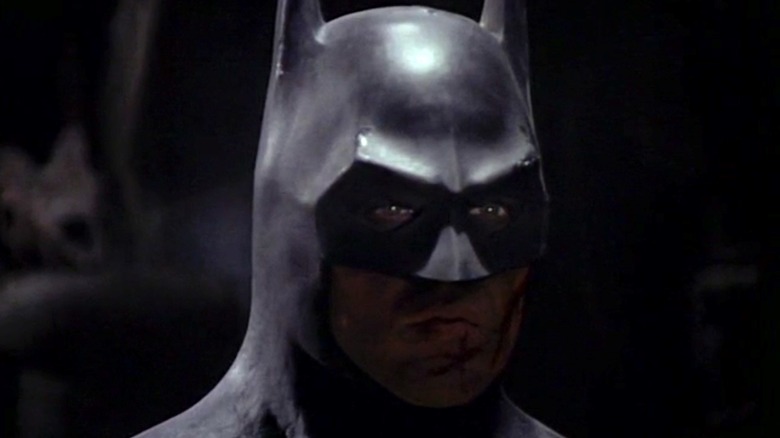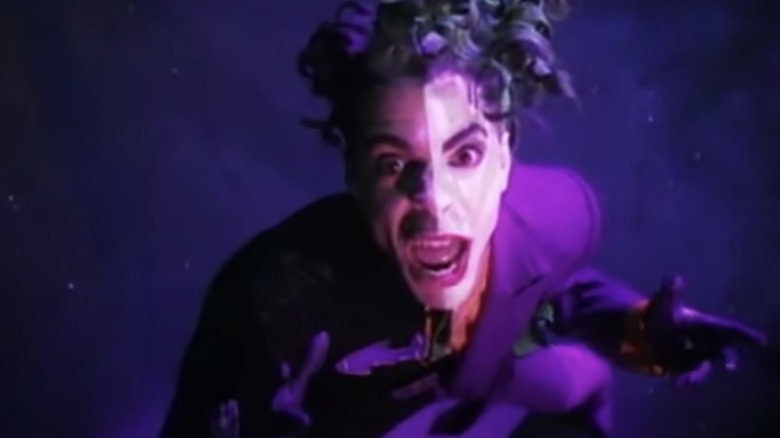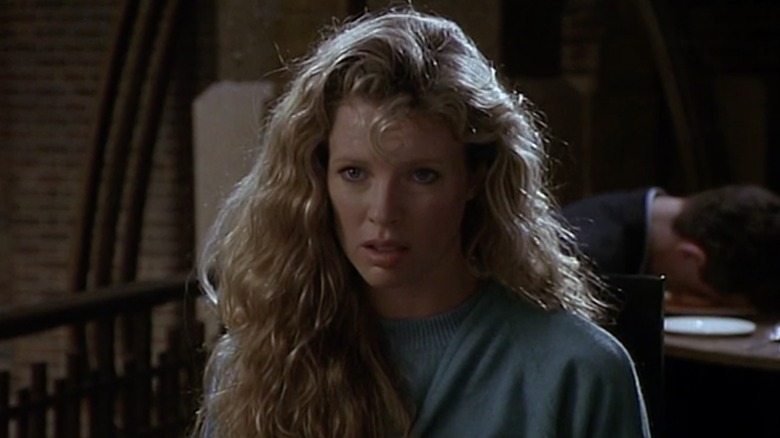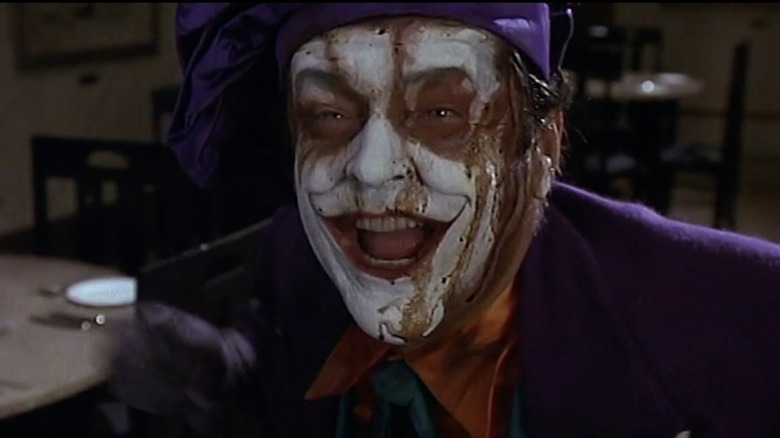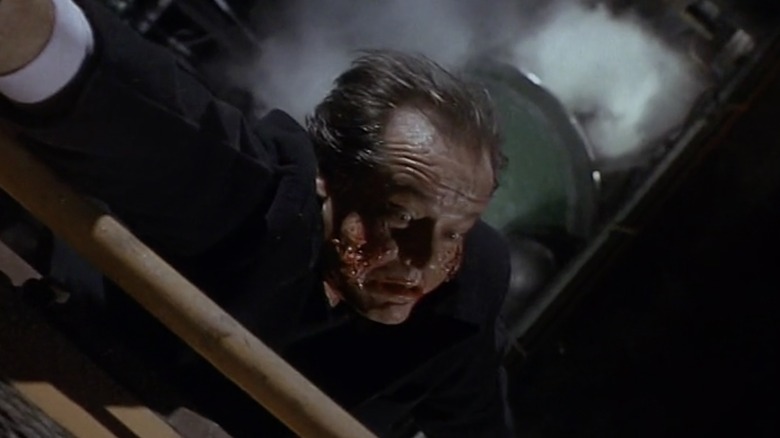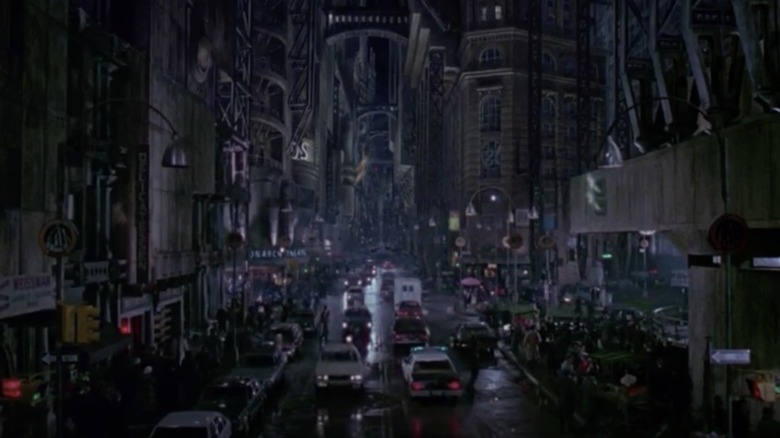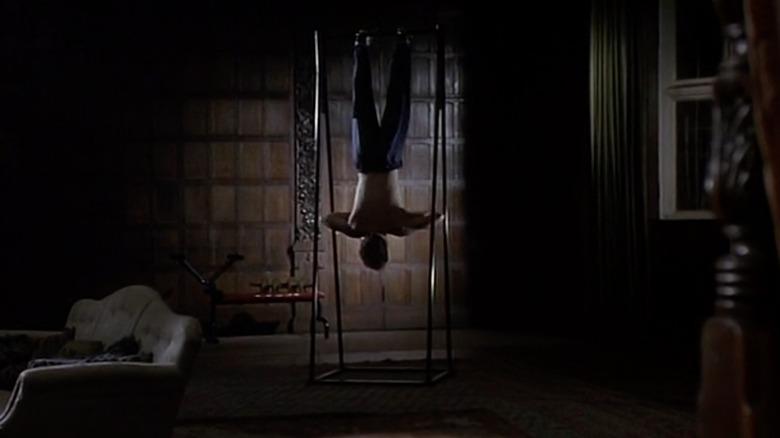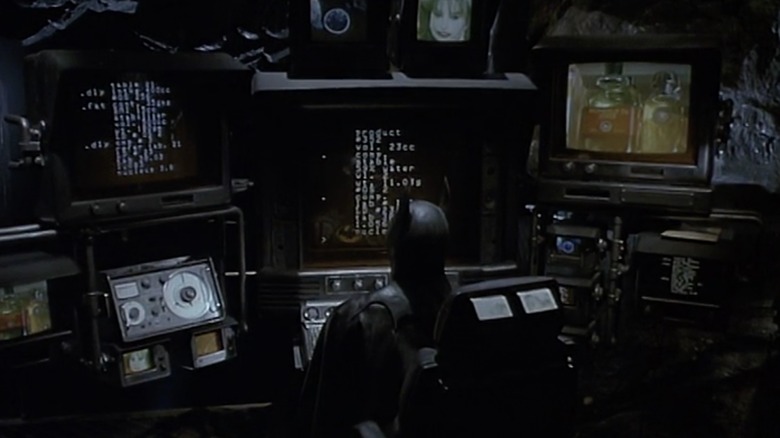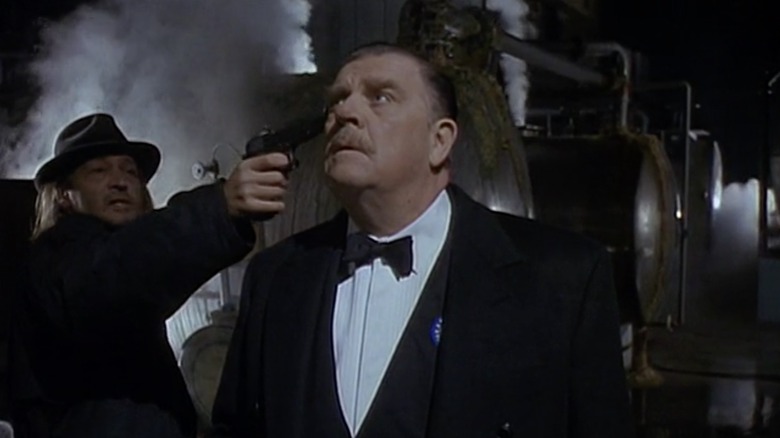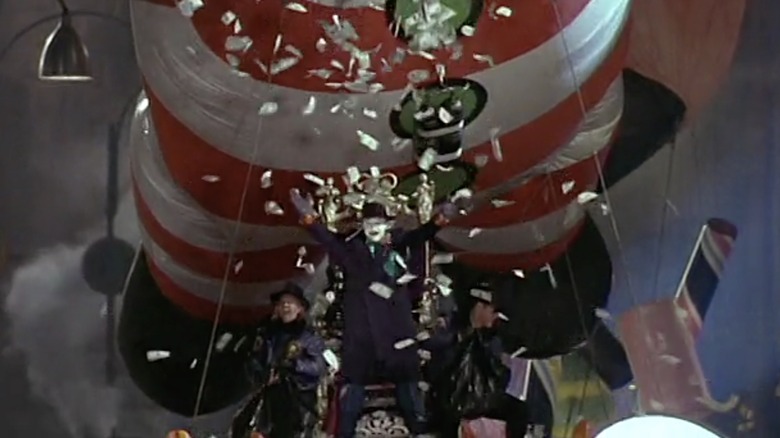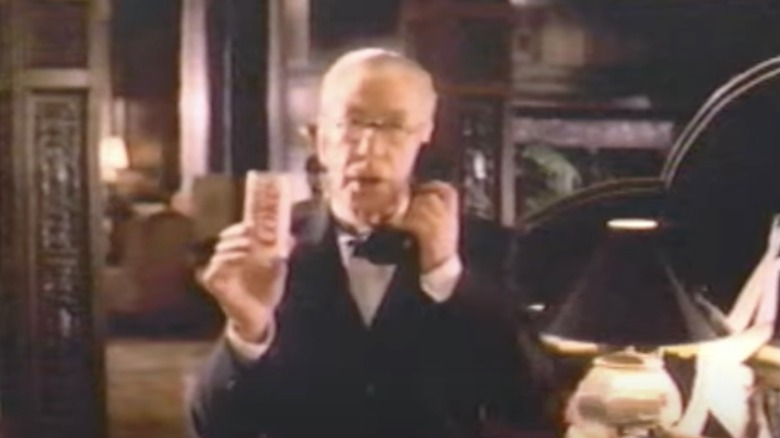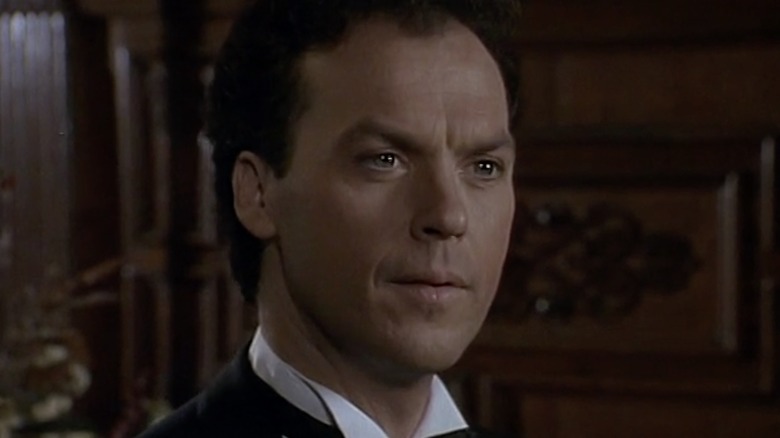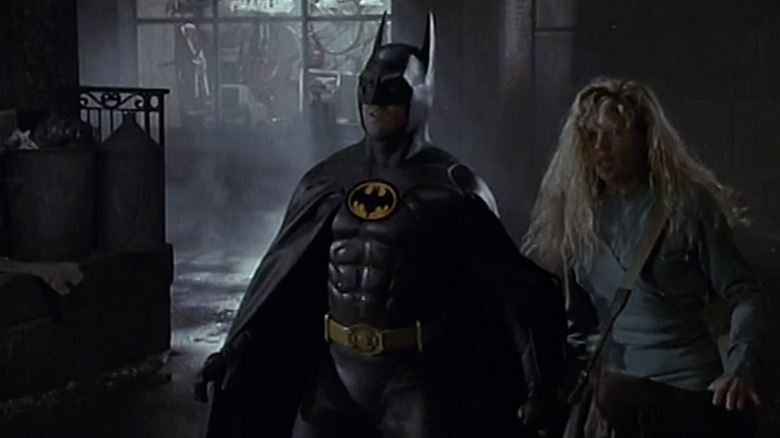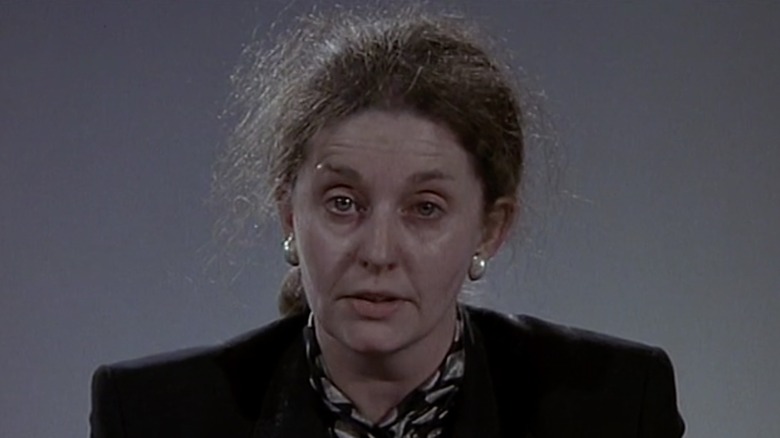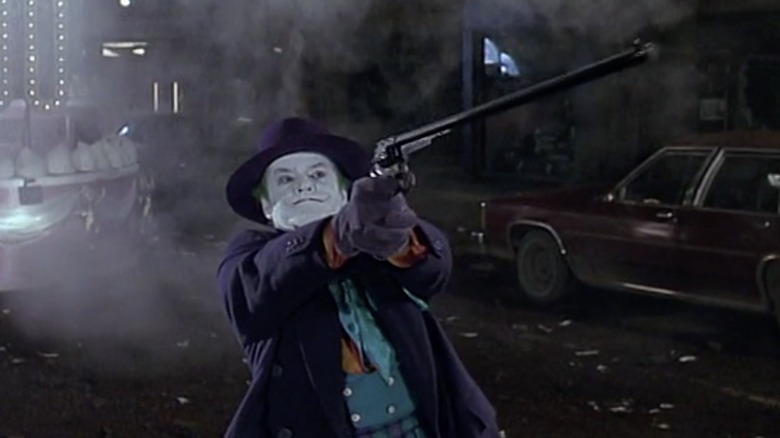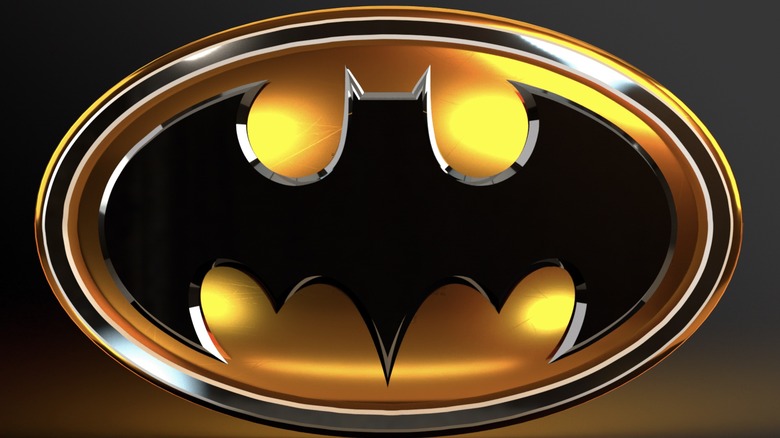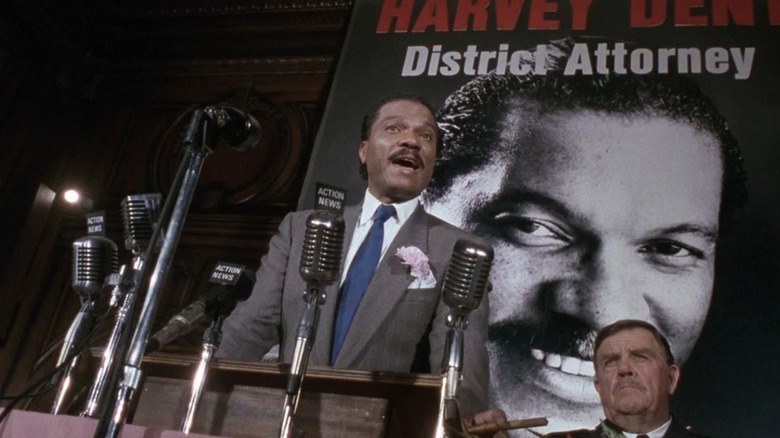The Best And Worst Things In Tim Burton's Batman
There are few things more admirable in the human experience than overcoming your fears. Even more admirable is transforming those fears into a weapon for justice and using it to pummel Jack Nicholson into the asphalt.
The wielder of this might in 1989 was Michael Keaton in Tim Burton's "Batman." Audiences had spent the previous year watching the actor's comical turn as "Beetlejuice" and were apprehensive about his ability to embody a brooding vigilante. But Keaton delivered the goods, helping yank the comic-book genre from childish entertainment into expansive appeal.
"Batman" is undeniably a product of its time. From fax machines to boomboxes, the production is packed with relics of its era. Regardless, even after over 30 years, it still manages to embody the spirit of Batman. The dark film even tosses aside the notion of Batman's aversion to killing by throwing henchmen off bell towers and crisping them up with generous amounts of explosives. It was a benchmark for dark, gritty comic-book adaptations before the genre was dragged, kicking and screaming, through the '90s.
"Batman" isn't without its foibles, but its strengths make those flaws become endearing, and it holds up well against modern depictions of The Caped Crusader. Here's the best (and worst) of what you'll see if you revisit the Burton classic.
Best: Songs by Prince
The late Minneapolis master of rock, pop, soul and funk was a major component in the assemblage of a soundtrack for "Batman." Throughout the '80s, producers had come to realize they had another cash-generating outlet via star-heavy soundtracks for their blockbuster films. Prince, a household name just a few years removed from his mid-'80s pinnacle of stardom, provided an array of tunes.
Prince fans know it was unlike him to sacrifice his artistic integrity to fit into a mold for some Hollywood movie. Fortunately, he didn't. The zany villainy of The Joker was juxtaposed perfectly alongside the glossy tunes of Prince, and his memorable music video would tap into the odd duality of the two nemeses.
The album led to a #1 position on the billboards for the artist, as well as yielding the iconic, heavily-played video for "Batdance". Prince's music also helped set the tone in several scenes through "Batman."
Take the Joker's romp through a local museum, for example, where they destroy valuable art with their own crude additions; boombox in tow, the sinister clown and his posse dance around the museum slapping fresh paint across masterpieces in sync to the beat of Prince's "Partyman." It is a mischievous display that demands a guilty chuckle.
Another memorable tone is struck when Prince's song "Trust" plays while The Joker parades through the streets of Gotham, throwing out $20 million in cash to the crowd. It helps accentuate the villain's flair for showmanship, and how he loves to use Gotham's own worst traits against itself.
Worst: Vicki Vale
The female archetype was in need of a massive overhaul in Hollywood for quite some time. Unfortunately, 1989 wasn't the year for course correction.
The character of Vicki Vale was among one of the worst aspects of "Batman." This is by no fault of Kim Basinger herself; her character is just poorly written. All her connections to the "Batman" story are loose affiliations meant to lead her to a climactic damsel-in-distress moment in the final moments of the film. Her introduction into the newspaper world is through Alexander Knox (Robert Wuhl), a man regularly ridiculed by co-workers for his belief in the existence of The Batman. Vicki is able to insert herself into the development of Knox's Batman article with little more than the statement that she likes bats (and the heavily implied fact that Knox is into her.)
Screenwriters could have spent time giving Basinger's character more depth. Vicki spends the entire film as the object of both The Joker and Batman's affections, represented by the two engaging in mental and physical combat while she stands frightened off to the side. She comes to the attention of The Joker through photographs taken by his number one guy, Bob (Tracy Walter) — whose unceremonious departure is too bad, because it seems like the deceased goon had a future in photography; the photos he takes of Vicki look like they could be on the cover of Vogue magazine.
Best: Jack Nicholson as The Joker
The repertoire of Joker renditions has expanded in the past several decades, with Heath Ledger's iconic turn as the maniacal clown often residing near the top of the list. What's ironic is that when Ledger was first cast, popular sentiment on the internet was that the "Knight's Tale" guy would never be able to approach Nicholson's deranged take.
For almost two decades, Nicholson was etched into the public consciousness as the face of The Joker — and for good reason. Overcoming the Caesar Romero camp expectations, the "Five Easy Pieces" Oscar nominee brought a larger than life, unpredictable glee to the villain, insatiable in his lust for chaos. Even the character's ghoulish makeup in "Batman" continues to create an unease every time he strolls into the scene.
Nicholson's decision to sign on as The Joker helped create the necessary buzz to elevate "Batman" to pop-culture phenomenon. In 1989, this would have been equivalent to Leonardo DiCaprio signing on to play a villain in a superhero film. And even that comparison doesn't do it justice, because superhero films weren't established as the sturdy cash cows they are today. Also, on top of his performance was the groundbreaking contract he signed with Warner Bros., which led to studios re-examining how much they offer on the back end.
Nicholson took a cut on his initial payout for his role as The Joker, in exchange for royalties on the film and merchandising. His resulting income from the film, reportedly, reached upwards of $90 million for the actor (or almost $194 million after adjusting for inflation).
Worst: Jack Napier's transformation into The Joker
While Nicholson's Joker is an amazing display, the elaborate set of circumstances leading to Jack Napier's transformation is laughable.
Cops are directed to the Axis chemical plant through a tip delivered by Jack's boss, Grissom, who is angry at Jack for having an affair with his girlfriend. This leads to his confrontation with Batman on a catwalk above ... what else? ... a vat of chemicals.
When Jack shoots at Batman, the vigilante dials into some superhuman reflexes and deflects the bullet with his fist, ricocheting it off nearby machinery. The stray bullet then zips straight back through Napier's cheeks. The sudden rush of pain causes him to tumble headfirst over a nearby railing, because that's what bad guys do when they get shot.
While dangling from rafters, Jack opts for the one-handed dangle cliche. His glove slips off and he is plunged into a pool of dangerous chemicals. After dramatically raising his mangled hand from the sewer depths, rather than surfacing for air, he visits a surgeon who attempts to fix the damaged nerves in his face. The supposed result is the permanent grin and bleached skin that we associate with The Joker.
Best: The noir aesthetic
The Batman comics' pages are drenched in black. Marrying that color palette with cinema can be a daunting task.
To tackle this ambition, Burton brought on production designer Anton Furst (known previously for his work on "Full Metal Jacket"). The result is a Gotham dripping with noir and gothic vibes that helps the hero-versus-villain story pop off the screen. Furst was able to make the city feel cramped and dingy in a way that, arguably, hasn't been matched since. Most likely because the grand set construction taken on by Furst would now be relegated to green screens and on-site filming. Furst's amazing effort assembled the Gotham City of "Batman" on 95 acres, built across 18 soundstages.
While some primary characters have more modern (or 1989) sensibilities, most of the background and side characters in "Batman" have a distinct 1940's aesthetic.
The cameras carried by Gotham's reporters operate on archaic flash bulb technology. The henchmen are clothed in noir gangster garb and engage in old school shootouts with the cops, complete with tommy guns. The entirety of Gotham appears to be constructed of concrete and shadows, with the buildings inching out into the sidewalk, smothering citizens. The grungy Gotham we got in "Batman" wasn't able to be replicated the same way in "Batman Returns"; Furst was unable to accept work on the sequel due to contractual obligations. He passed away in 1991, with "Awakenings" being his final film project.
Worst: Upside down Michael Keaton
There isn't any background given as to why exactly Bruce Wayne chooses bats as his superheroic inspiration in "Batman." Audiences are left to make wild assumptions.
Perhaps his parent's death left him with an angst that evolved into a goth phase and a fascination with the vampiric that has lingered into adulthood. Maybe he fell down a well, was harassed by an army of bats, and the trauma of this event led him to conquer his fears by embodying said fear. Who knows? It does seem likely, however, that Bruce Wayne is not part bat. The audience just can't be sure Tim Burton and crew know this.
Bruce Wayne invites Vicki Vale over to his gigantic mansion, where they have some soup. The billionaire then hands off charming duties to his butler while he focuses on maintaining his air of mystery. Vicki and Bruce share a passionate kiss before cuddling up in a cozy bed. It is apparent that Bruce has trouble sleeping at night — he is a creature of the night, after all.
When Vicki wakes up, she looks over to see Bruce Wayne hanging upside down, gently swinging on an apparatus of some sort. Is this implying he sleeps better hanging upside down like a bat? Is it an attempt at humor? Either way, it feels like an unnecessary, confusing creative choice.
Best: Where does he get all those wonderful toys?
Learning how it's made is a fun activity for nurturing the logic center of brains, but other times it's better to simply watch heroes sail into the rafters with little thought to pulley systems and weight distribution.
Most new-age Batman incarnations dive into the practicality behind his gadgets, as well as their construction, robbing the audience of precious minutes they could instead be watching him use them. There is an itch that comes along with the glowing Batman insignia in the opening credits, and that itch will not be scratched until The Dark Knight whips out a razor-edged bat boomerang and flings it towards an unwitting goon.
"Batman" has all the goods in the gadgetry department. The hero's grappling hook is utilized gratuitously. His smoke bombs allow for dramatic skylight exits, and The Batmobile is a gloriously cartoony adaptation equipped with the ability to encase itself in an impenetrable shell and drop devastating bombs from its hubcaps.
When Batman isn't decimating chemical factories with his tech, he is zipping through the air in his Batwing — the 1989 model of which comes equipped with a giant pair of scissors fastened to the front, just in case any Gotham baddies decide to march down the city streets wielding parade balloons filled with deadly gas.
Worst: Pushing Commissioner Gordon to the background
Commissioner Gordon has long been a crucial character in the Batman comics. The mustachioed officer of the law has been a staple of Batman's story since its inception, in fact; Gordon was in the first panel of the very first appearance of Batman in "Detective Comics" #27, predating even Alfred and Robin.
Batman and Gordon typically have a close relationship, built on mutual respect and trust. Gordon may not always agree with Batman's methods, but he recognizes that he is a force for good. The criminals of Gotham City do not fight fair, and Batman is there to assist the commissioner with a flurry of fists and unsanctioned investigations. So, it was disappointing when the 1989 film represented Gordon as a useless, bumbling, barely relevant to the plot fool.
Played by Pat Hingle (a poor casting choice), this befuddled Gordon is useless, aside from holding news conferences. Circumstances make it clear that Batman and Gordon have never even talked face-to-face — a disappointing, unnecessary story element. Hingle would go on to play Commissioner Gordon in the next three Batman films as well, and the relationship between the two characters grew slightly, but not much. Any character development on Gordon in live-action Batman films would have to wait until 2008's "The Dark Knight."
Best: The Joker's big plan to gas the whole city
Criticism of "Batman" came primarily in the form of storytelling complaints. Some critics claimed the film got lost in its own style and forgot to tell a compelling story, but Jack Napier's story in particular is told in great detail, from an affair with the wife of Grissom (Jack Palance) that leads to his acid-based rebirth, back to his roots in petty crime.
Following those developments, the clown's initial plan is to poison the cosmetics in Gotham City with a poison known as Smylex. The psychopathic hijinx is almost enough to make the viewer forget they're watching Gothamites dropping dead with horrific, lifeless grins attached to their faces. When this plan is foiled by Batman's chemistry prowess, Joker turns to a more heavy-handed approach.
The saboteur knows an opportunity when he sees one. That opportunity presents itself when the Mayor cancels the city's anniversary celebration on grounds of excess villainy. Joker bogarts the desire for celebration, announces his own parade, and adds the extra incentive of $20 million in cash being dispersed among attendees. Using "Gotham's greed" (as Robert Wuhl's Knox proclaims), he lures citizens out into the streets where he can shower them with Smylex via absurdist parade floats. The entire plan is so uniquely Joker and speaks to the nature of Gotham City itself. It is one of the best elements at play in "Batman".
Worst: Shameless product plugs
At the heart of Hollywood is an immense river of money, ever-raging and hungry for more. These big-budget entertainment displays would not exist for our enjoyment were financiers not receiving a return on their investments. Producers have evolved over the years, recognizing money can be raked in from more than just ticket sales. One such tool that is utilized for extra cash flow is product placement. Many are able to approach this with more nuance nowadays, but in 1989 its use could best be described as blunt-force advertising.
"Batman" filmmakers tapped into the magazine industry by plugging both Vogue and Time magazine, utilizing Vicki Vale's background as a fashion magazine photographer as their in. There are several instances of the use of a Nikon camera (by both Vicki and Joker's henchman). The film's opening scene, involving two burglars in the alley, shows the men rifling through a stolen wallet and removing an American Express card. The thief sarcastically says, "American Express. Don't leave home without it."
But perhaps the most brazen marriage of Batman and marketing came in the form of this commercial for Diet Coke. While that commercial obviously wasn't a part of the film, it aired with such regularity that the essence of Batman felt tainted.
Best: Bruce Wayne's mystique
Batman is a man of the shadows. From his custom Nike boots to his eyeliner, the caped crusader is a denizen of the night who is happy having no affiliations. Bruce Wayne, on the other hand, is a wealthy businessman who works tirelessly to better his hometown — as we've seen time and again in subsequent films. However, in 1989's "Batman," the audience does not get this information. The man behind the mask is presented with just as much mystique as his heroic counterpart. Keaton's Bruce Wayne is portrayed as a man with a massive bank account and a smirk that hints he knows something you don't.
At the core of Batman mythos is the demise of his parents. It's ingrained in pop-culture right next to "with great power, comes great responsibility." But even that backstory is only lightly touched on in "Batman," as the deaths of Bruce's parents is revealed in quick detail more than halfway through the film – mostly to create an emotional connection to his nemesis. The nuance of Bruce's daily business and social maintenance are chucked aside in lieu of developments on The Joker's depravity and Batman's heroic endeavors. The mysterious nature of Bruce Wayne is one of the many reasons Michael Keaton's version remains so well-regarded.
Worst: The bat suit
It's not hard to imagine the odor that must have emanated from Michael Keaton's rubber suit after a day brooding on set. The getup looks mercilessly restraining every time Batman is fighting crime, and it is clear that Keaton can't turn his head in the suit. Whenever he needs to redirect his line of sight, his entire body shifts like a statue with a compacted spine. The batsuit in "Batman" hardly looks suitable for hand-to-hand combat.
Regardless of the visible constraints, the cowl itself delivers the required aesthetic, but the appeal ends there. From the neck down, Keaton looks as if he is welded into a tire with abs. The yellow Batman insignia on the center of his chest leaps out so jarringly, meanwhile, you wonder if Burton was worried the audience would forget who they were looking at. The cape for The Caped Crusader also manages an excess of cheesiness, one that wouldn't be bothersome if Batman didn't spend so much time dramatically swirling his cape around when exiting a scene.
Best: The comic relief
All dark tales are more intriguing when injected with levity. Humor can give a moment of emotional reprieve before a film yanks the carpet out from the audience.
Burton created an undeniably dark Batman story, but he is also known for his quirky sense of humor, which seeped through at surprising times in "Batman." Among the best is Gotham's response to The Joker's first wave of terror, inflicted upon the cosmetics industry.
When citizens hear people have suddenly begun laughing themselves to death, panic spreads. Information reveals that the city's beauty supplies have been poisoned with Smylex, so everyone stops using makeup. Subsequent newscasts are then told via reporters who are visibly haggard in appearance, unable to apply makeup before going on the air.
The anchors' grayish skin and saggy, red eyes are Burton commenting on the artifice of our daily lives, and how Joker is trying to burn it all down. Notable mention for top-notch, comic-book buffoonery also goes to the goon who tries to ambush Batman in the final battle. The henchman leaps from a nearby ledge and doesn't quite reach his target, instead falling straight through the wood floor behind Batman.
Worst: Joker shooting down the batwing with a pistol
Sure, a suspension of disbelief can be a necessary element when a film earns it, allowing audiences to believe that a Pontiac Fiero can be retrofitted for space travel or that there is a platform 9 & 3/4s somewhere in London. But in the final climactic moments of "Batman," things get out of control.
After The Joker's plan has been disrupted by Batman flying through in his trusty batwing, the villain resorts to some unconventional firepower. The Joker reaches into his waistband and removes a pistol with a comically long barrel that had to have been constricting while he was dancing to Prince tunes. Batman revs up his batwing and swoops down between the skyscrapers in preparation for a flyby. As he closes in, The Joker fires off one shot that sends the batwing into a death spiral.
This is one of the worst moments in an otherwise entertaining sequence of events. Apparently, the filmmakers wanted the batwing to stop the gassy balloons and pose for an iconic image with the full moon — then they trashed it in the laziest way possible.
Best: The Batman rebrand
It is difficult to imagine a world without Batman's story being common knowledge but, before movies regularly sourced their material from comic books, these stories were relegated to attic crawl spaces and the bookshelves of a dedicated minority. This was partly thanks to the schtick of Adam West.
Nowadays, fans find West's classic TV show both hilarious and endearing, but it created an image of The Dark Knight that made him a punchline, and for more than twenty years, it was a hindrance — until Tim Burton got his hands on a Batman script that everything changed.
Burton recognized Batman for the grim character he could be, and not just the stuff of childhood fantasy. He exchanged the colorful whimsy of past adaptations for a dark, serious tone. Any comical aspects were smoothed over with depravity, and "Batman" matched its critical appeal with massive box office success, becoming the fastest film in history to reach the $100 million mark. The superhero genre was forever changed.
Worst: The Harvey Dent that never was
With the amount of marketing placed behind "Batman" prior to its June 23, 1989 release, it was obvious Warner Bros. was interested in releasing further heroic tales from Gotham City. The coterie of supervillains in Batman comics is expansive, and among the most well-known is Two-Face, otherwise known as Harvey Dent.
In 1989's "Batman," Dent was played by Billy Dee Williams (known for his role as Lando Calrissian in "Star Wars") — and later played by Tommy Lee Jones (1995's "Batman Forever") and Aaron Eckhart (2008's "The Dark Knight"), with varying degrees of absurdity. All these years later, it feels like a missed opportunity that Williams never got to play the flip side of the coin.
Williams wasn't even brought back for Burton's sequel — supposedly to help separate "Batman Returns" from the first film. By the third movie, Joel Schumacher was brought in to take over the Batman franchise and took it in a different direction, once again embracing campier elements.
All these years later, the "what could have been" element for the Billy Dee Williams Two-Face that never was remains so strong that an edition of the "Batman '89" comic book released in 2021 featured Billy Dee Williams as Harvey Dent. Better late than never.
